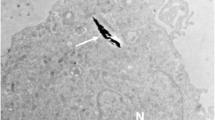Abstract
To investigate the inhibition of gap junction mediated intercellular communication (IC) by extracts of airborne particulate matter (APM), V79 cells were incubated with extracts of APM and subsequently microinjected with the fluorescent dye Lucifer Yellow, after which the number of fluorescent (= communicating) cells was determined. To compare inhibitory effects on IC with mutagenicity, APM was also tested in the Salmonella microsome assay. Six different extracts were tested, two outdoor extracts representing a heavily polluted and a relatively clean sample, and four indoor extracts, taken either in livingrooms with or without wood combustion in an open fire place, or in a room with or without cigarette smoking. Non-cytotoxic doses of outdoor and indoor APM inhibited IC in V79 cells in a dose- and time-dependent manner. Mutagenicity data and IC data were correlated. These results suggest that APM has tumor promoter activity in addition to mutagenic activity.
Similar content being viewed by others
References
Alfheim I, Ramdahl T (1984) Contribution of wood combustion to indoor air pollution as measured by mutagenicity in Salmonella and polycyclic aromatic hydrocarbon concentration. Environ Mutagen 6: 121–130
Alink GM, Smit HA, van Houdt JJ, Kolkman JR, Boleij JSM (1983) Mutagenic activity of airborne particles at non-industrial locations. Mutat Res 116: 21–34
Ames BN, McCan J, Yamasaki E (1975) Methods for detecting carcinogens and mutagens with the Salmonella/mammalian microsome mutagenicity test. Mutat Res 31: 347–364
Atkinson MM, Menko AS, Johnson RG, Sheppard JR, Sheridan JD (1981) Rapid and reversible reduction of junctional permeability in cells infected with a temperature-sensitive mutant of avian sarcoma virus. J Cell Biol 91: 573–578
Castagna M, Takai Y, Kaibuchi K, Sano K, Kikkawa U, Nishizuka Y (1982) Direct activation of calcium-activated phospholipid-dependent protein kinase by tumor-promoting phorbol esters. J Biol Chem 257: 7847–7851
Chida K, Hashiba H, Sasaki K, Kuroki T (1986) Activation of protein kinase C and specific phosphorylation of a Mr 90.000 membrane protein of promotable BALB/3T3 and C3H/10T1/2 cells by tumor promoters. Cancer Res 46: 1055–1062
Dehnen W, Pitz N, Tomingas R (1977) The mutagenicity of airborne particulate pollutants. Cancer Lett 4: 5–12
Enomoto T, Yamasaki H (1985) Phorbol ester-mediated inhibition of intercellular communication in BALB/C 3T3 cells: relationship to enhancement of cell transformation. Cancer Res 45: 2681–2688
Houdt van JJ, Jongen WMF, Alink GM, Boleij JSM (1984) Mutagenic activity of airborne particles inside and outside homes. Environ Mutagen 6: 861–869
Houdt van JJ, Daenen CMJ, Boleij JSM, Alink GM (1986) Contribution of wood stoves and fire places to mutagenic activity of airborne particulate matter inside homes. Mutat Res 171: 91–98
Houdt van, JJ, Alink GM, Boleij JSM (1987) Mutagenicity of airborne particles related to meteorological and air pollution parameters. Sci Total Environ 61: 23–36
Jongen WMF, Sijtsma SR, Zwijsen RML, Temmink JHM (1987) A co-cultivation system consisting of primary chick-embryo hepatocytes and V79 Chinese hamster cells as a model for metabolic cooperation systems. Carcinogenesis 9: 767–772
Krishna GJ, Nath J, Ong T (1984) Correlative genotoxicity studies of airborne particles in Salmonella typhimurium and cultured lymphocytes. Environ Mutagen 6: 584–592
Lo CW, Gilula NB (1979) Gap junctional communication in the post-implantation mouse embryo. Cell 18: 411–422
Loewenstein WR (1979) Junctional communication and the control of growth. Biochem Biophys Acta 560: 1–65
McGaffrey PG, Rosner MR (1987) Growth state-dependent regulation of protein kinase C in normal and transformed murine cells. Cancer Res 47: 1081–1086
Murray AW, Fitzgerald DJ (1979) Tumor promoters inhibit metabolic cooperation in cocultures of epidermal and 3T3 cells. Biochem Biophys Res Commun 91: 395–401
Nishizuka Y (1986) Studies and perspectives of protein kinase C. Science 233: 305–312
Pitts JN, Grosjean D, Mischke TM (1977) Mutagenic activity of airborne paniculate organic pollutants. Toxicol Lett 1: 65–70
Rodrigues-Pena A, Rozengurt E (1984) Disappearance of Ca2+-sensitive, phospholipid-dependent protein kinase activity in phorbol estertreated 3T3 cells. Biophys Res Commun 120: 1053–1059
Rutten AAJJL, Jongen WMF, Haan De LHJ, Hendriksen EGH, Koeman JH (1989) Effect of retinol and cigarette-smoke condensate on dyecoupled intercellular communication between hamster tracheal epithelial cells. Carcinogenesis 9: 315–320
Seemayer NH, Manojlovic N, Tomingas R (1986) Induction of malignant cell transformation in vitro by extract and fractions of airborne paniculate matter. J Aerosol Sci 17: 356–360
Stewart WW (1978) Functional connections between cells as revealed by dye coupling with a highly fluorescent naphtalimide tracer. Cell 14: 741–759
Talcott R, Wei E (1977) Airborne mutagens bioassayed inSalmonella typhimurium. J Natl Cancer Inst 58: 449–451
Tokiwa H, Morita K, Takeyoshi A, Takahashi K, Ohnishi Y (1977) Detection of mutagenic activity in particulate air pollutants. Mutat Res 48: 237–248
Trosko JE (1987) Mechanisms of tumor promotion: possible role of inhibited intercellular communication. Eur J Cancer Clin Oncol 23: 599–601
Trosko JE, Yotti LP, Warren ST, Tsushimoto G, Chang C (1982) Inhibition of cell-cell communication by tumor promoters. In: Hecker E, Kunz W, Fusenig NE, Marks F, Thielman HW (eds) Carcinogenesis vol 7. Raven Press, New York, pp 565–585
Yamasaki H (1984a) In vitro approaches to identify tumor promoting agents: cell transformation and intercellular communication. Food Addit Contam 1: 179–187
Yamasaki H (1984b) Modulation of cell differentiation by tumor promoters. In: Slaga TJ (Ed) Mechanisms of tumor promotion, vol IV. CRC Press, Boca Raton, Florida, pp 1–26
Yotti LP, Chang CC, Trosko JE (1979) Elimination of metabolic cooperation in Chinese hamster cells by a tumor promoter. Science 206: 1089–1091
Zandt Van Der PTJ, Feijter De AW, Homan EC, Spaaij C, Haan De LHJ, Aelst Van AC, Jongen WMF (1990) Effects of cigarette smoke condensate and 12-O-tetradecanoylphorbol-13-acetate on gap junction structure and function in cultured cells. Carcinogenesis 11: 883–888
Zeilmaker MJ, Yamasaki H (1986) Inhibition of junctional intercellular communication as a possible short-term test to detect tumor-promoting agents: results with nine chemicals tested by dye transfer assay in Chinese hamster V79 cells. Cancer Res 46: 6180–6186
Author information
Authors and Affiliations
Rights and permissions
About this article
Cite this article
Heussen, G.A.H. Inhibition of intercellular communication by airborne particulate matter. Arch Toxicol 65, 252–256 (1991). https://doi.org/10.1007/BF02307317
Received:
Accepted:
Issue Date:
DOI: https://doi.org/10.1007/BF02307317




